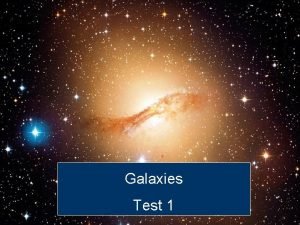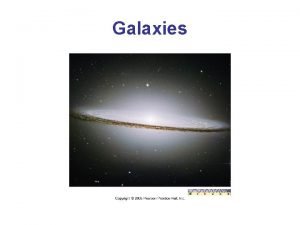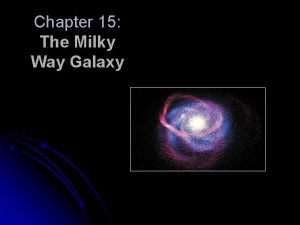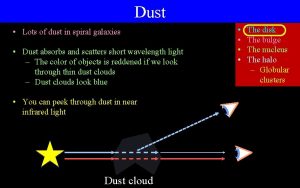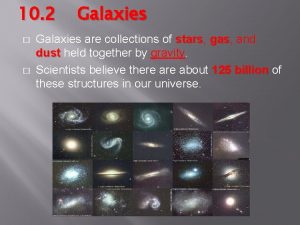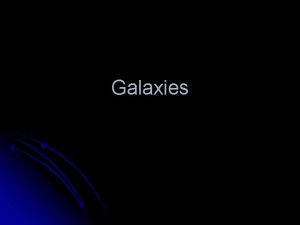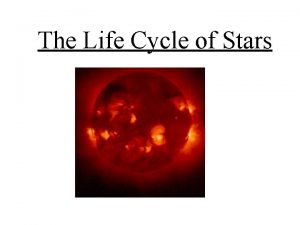Galaxies Galaxies are huge collections of stars dust















- Slides: 15

Galaxies

Galaxies are huge collections of stars, dust and gas. They usually contain several million to over a trillion stars and can range in size from a few thousand to several hundred thousand light-years across. There are hundreds of billions of galaxies in the Universe. Galaxies come in many different sizes, shapes and brightnesses and, like stars, are found alone, in pairs, or in larger groups called clusters. Galaxies are divided into three basic types: spirals, ellipticals and irregulars

Collisions • The shapes of galaxies are influenced by their neighbours, and, often, galaxies collide. The Milky Way is itself on a collision course with our nearest neighbour, the Andromeda galaxy. Even though it is the same age as the Milky Way, Hubble observations reveal that the stars in Andromeda's halo are much younger than those in the Milky Way. From this and other evidence, astronomers infer that Andromeda has already smashed into at least one and maybe several other galaxies.

The Milky Way • We live in a somewhat remote arm of the Milky Way. Our galaxy, the Milky Way is typical: it has hundreds of billions of stars, enough gas and dust to make billions more stars. And it’s all held together by gravity. • Like more than two-thirds of the known galaxies, the Milky Way has a spiral shape. At the centre of the spiral, a lot of energy and, occasionally, vivid flares. are being generated. Based on the immense gravity that would be required explain the movement of stars and the energy expelled, the astronomers conclude that the centre of the Milky Way is a supermassive black hole.

Milky Way Galaxy Facts • The Milky Way began as a series of dense regions in the early universe not long after the Big Bang. The first stars to form were in clusters that still exist. They are among the oldest stars formed in the Milky Way region. • The Milky Way has grown by merging with other galaxies through time. It is currently acquiring stars from a very small galaxy called the Sagittarius Dwarf Spheroidal, as well as gobbling up material from the Magellanic Clouds. • The Milky Way moves through space at a velocity of about 552 kilometres per second (343 miles per second) with respect to the Cosmic Microwave Background radiation. • The Milky Way’s central core contains a supermassive black hole. It contains the mass of about 4. 3 million Suns. • The stars, gas and dust of the Milky Way all orbit the centre at a rate of about 220 kilometres per second. This constant rate for all stars at different distances from the core implies the existence of a shell of dark matter surrounding our galaxy. • Our galaxy will collide with Andromeda Galaxy in about 5 billion years. Some astronomers refer to our two galaxy as a binary system of giant spirals.

Types Of Galaxies q Spiral Galaxies q Elliptical Galaxies q Irregular Galaxies

• Spiral galaxies are the most common type in the universe. Our Milky Way is a spiral, as is the rather closeby Andromeda Galaxy. Spirals are large rotating disks of stars and nebulae, surrounded by a shell of dark matter. The central bright region at the core of a galaxy is called the “galactic bulge”. Many spirals have a halo of stars and star clusters arrayed above and below the disk. • Spirals that have large, bright bars of stars and material cutting across their central sections are called “barred spirals”. A large majority of galaxies have these bars, and astronomers study them to understand what function they play within the galaxy. In addition to bars, many spirals may also contain supermassive black holes in their cores. Subgroups of spirals are defined by the characteristics of their bulges, spiral arms, and how tightly wound those arms are. Spiral Galaxies

Elliptical Galaxies • Elliptical galaxies are roughly egg-shaped found largely in galaxy clusters and smaller compact groups. Most ellipticals contain older, low-mass stars, and because they lack a great deal of starmaking gas and dust clouds, there is little new star formation occurring in them. Ellipticals can have as few as a hundred million to perhaps a hundred trillion stars, and they can range in size from a few thousand light-years across to more than a few hundred thousand. Astronomers now suspect that every elliptical has a central supermassive black hole that is related to the mass of the galaxy itself. Messier 87 is an example of an elliptical galaxy. There are some subgroups of ellipticals, including “dwarf ellipticals” with properties that put them somewhere between regular ellipticals and the tightly knit groups of stars called globular clusters.

Irregular Galaxies • Irregular galaxies are as their name suggests: irregular in shape. The best example of an irregular that can be seen from Earth is the Small Magellanic Cloud. Irregulars usually do not have enough structure to characterise them as spirals or ellipticals. They may show some bar structure, they may have active regions of star formation, and some smaller ones are listed as “dwarf irregulars”, very similar to the very earliest galaxies that formed about 13. 5 billion years ago. Irregulars are characterised by their structures (or lack of them).

Antennae Galaxies • The Antennae is a pair of spiral galaxies that are interacting and mingling their stars. They began their galactic dance over a few hundred million years ago and are currently in a period where their colliding gas clouds are bursting with new star formation. As the two galaxies merge, their gravitational interactions pull long tails of gas away from each other, and these tails are the sites of starburst activity. In a few billion years, the cores of these two galaxies will be combined into one large core, with a supermassive black hole at its heart. It will be surrounded by an elliptical galaxy of old stars.

• Spiral galaxies that combine as the Antennae are doing will most likely ultimately end up as elliptical galaxies. The merger will erase all traces of their spiral arms. • It is likely that when the Milky Way and the Andromeda Galaxies combine, they will look similar to the Antennae during at least one point of their interaction. • Of the millions of new stars created during the Antennae merger, only about ten percent of them will live longer than 10 million years. That’s because they will be massive blue supergiants, a type of star that quickly consumes its nuclear fuel and explodes as a supernova. • The remaining massive young star clusters formed during starburst activity will become the new galaxy’s globular clusters. • The Antennae galaxies are the closest colliding galaxies to the Milky Way.

Andromeda Galaxy • The Andromeda Galaxy (M 31) is the closest large galaxy to the Milky Way and is one of a few galaxies that can be seen unaided from the Earth. In approximately 4. 5 billion years the Andromeda Galaxy and the Milky Way are expected to collide and the result will be a giant elliptical galaxy. Andromeda is accompanied by 14 dwarf galaxies, including M 32, M 110, and possibly M 33.

Andromeda Galaxy Designation – M 31, NGC 224 Type – Spiral Distance from Milky Way – 2. 5 million light – years Diameter – 260, 000 light – years Mass – 400 billion solar masses Number of Stars – 1 trillion

Andromeda Galaxy Facts • While Andromeda is the largest galaxy in the Local Cluster it may not be the most massive. The Milky Way is thought to contain more dark matter, which could make it much more massive. • Since it is the nearest spiral galaxy to us, astronomers use the Andromeda Galaxy to understand the origin and evolution of such galaxies. • The Andromeda Galaxy is approaching the Milky Way at approximately 100 to 140 kilometres per second. • The Andromeda Galaxy has a very crowded double nucleus. Not only does it have a massive star cluster right at its heart, but it also has at least one supermassive black hole hidden at the core. • The spiral arms of the Andromeda Galaxy are being distorted by gravitational interactions with two companion galaxies, M 32 and M 110. • The Andromeda Galaxy has at least two spiral arms, plus a ring of dust that may have come from the smaller galaxy M 32. Astronomers think that it may have interacted more closely with Andromeda several hundred million years ago, when M 32 plunged through the heart of its larger neighbour. • The Andromeda Galaxy is the most distant object you can spot with the naked eye. You need a good spot away from bright lights in order to see it.

Sources • www. space. com
 Huge collections of stars
Huge collections of stars Insidan region jh
Insidan region jh What waves are produced by stars and galaxies
What waves are produced by stars and galaxies The rwenzori mountains mary daniels is a student in england
The rwenzori mountains mary daniels is a student in england 4 types of galaxies
4 types of galaxies Elliptical galaxies facts
Elliptical galaxies facts Evolution of galaxies
Evolution of galaxies Chapter 30 galaxies and the universe
Chapter 30 galaxies and the universe How are galaxies classified? *
How are galaxies classified? * Th eirregulars
Th eirregulars Billions of galaxies
Billions of galaxies What are galaxies
What are galaxies Tipus de galaxies
Tipus de galaxies Galaxys
Galaxys Era of galaxies
Era of galaxies Galaxies lesson plan
Galaxies lesson plan




